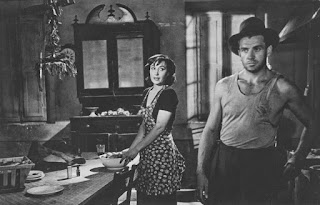Luchino Visconti
Some scholars may argue that Italian neorealism perhaps was born earlier than Rossellini’s Rome, Open City. Luchino Visconti’s Ossessione (1943), an adaptation of James M. Cain’s The Postman Always Rings Twice uses squalid and realistic settings as background for its personal, psychological action. The film stands in clear opposition to the romanticism of Hollywood. Mast and Kawin explain that social realism becomes part of Ossessione’s style (its soil), rather than its subject. If neorealism is defined by how its films are made (i.e. on location shooting, using non-actors, and exploring subject matter that was born out of war), Ossessione doesn’t strictly fall in line. Yet the style of Visconti’s film exhibits many of the traits of neorealism, leading some to identify Ossessione as among the first neorealist films. Visconti slows down the pace of the film to offer us a view into the routine of his characters. He seldom uses close-ups, instead employing long and medium shots. There is an emphasis on landscape and location that may be described as realistic.
In the following scene, Gino (Massimo Girotti), a wanderer, enters a tavern/gas station owned by Giovanna (Clara Calamai) and her older husband Giuseppe (Juan da Landa). The attraction between Gino and Giovanna is obvious.
Ossessione (Luchino Visconti, 1943):
Clip from class Clip from Class
Its' possible Italian neorealism started earlier (Than with Open City)
with Luchino Visconti's Ossessione. (an adaptation of James M Cain's
The Postman Always Rings Twice but in realism (Opposite of Hollywood's romanticism)and squalid settings. Has psychological action.
The textbook Mast and Kawin explain that social realism is part of the films style rather than subject.
It's missing some key aspects of neorealism (on location shooting, non-actors or a subject born out of war. The traits it does show the routine of his characters; an emphasis on landscape and locations that are realistic. So Ossessione is counted as a neorealist film.
This scene shows a handsome wanderer (Gino) entering a bar and meeting the owner's wife Giovanna (Clara Calamai). He older and fat husband Giuseppe walks in and catches her giving him food but there is a strong attraction between Gino and Giovanna.
Ossessione (Luchino Visconti, 1943):
Interesting Essay on Ossessione - Click HereOssessione Full Film - Click Here
YouTubers -Coffee with Aliens at the Movies Review Ossessione Click Here


No comments:
Post a Comment